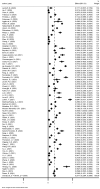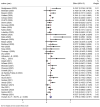Kidney health in the COVID-19 pandemic: An umbrella review of meta-analyses and systematic reviews
- PMID: 36172213
- PMCID: PMC9511113
- DOI: 10.3389/fpubh.2022.963667
Kidney health in the COVID-19 pandemic: An umbrella review of meta-analyses and systematic reviews
Abstract
Background: This umbrella review aims to consolidate evidence from systematic reviews and meta-analyses investigating the impact of the coronavirus disease-2019 (COVID-19) on kidney health, and the associations between kidney diseases and clinical outcomes in COVID-19 patients.
Methods: Five databases, namely, EMBASE, PubMed, Web of Science, the Cochrane Database of Systematic Reviews and Ovid Medline, were searched for meta-analyses and systematic reviews from January 1, 2020 to June 2, 2022. Two reviewers independently selected reviews, identified reviews for inclusion and extracted data. Disagreements were resolved by group discussions. Two reviewers independently assessed the methodological quality of all included reviews using ROBIS tool. A narrative synthesis was conducted. The characteristics and major findings of the included reviews are presented using tables and forest plots. The included meta-analyses were updated when necessary. The review protocol was prospectively registered in PROSPERO (CRD42021266300).
Results: A total of 103 reviews were identified. Using ROBIS, 30 reviews were rated as low risk of bias. Data from these 30 reviews were included in the narrative synthesis. Ten meta-analyses were updated by incorporating 119 newly available cohort studies. Hospitalized COVID-19 patients had a notable acute kidney injury (AKI) incidence of 27.17%. AKI was significantly associated with mortality (pooled OR: 5.24) and severe conditions in COVID-19 patients (OR: 14.94). The pooled prevalence of CKD in COVID-19 patients was 5.7%. Pre-existing CKD was associated with a higher risk of death (pooled OR: 2.21) and disease severity (pooled OR: 1.87). Kidney transplant recipients were susceptible to SARS-CoV-2 infection (incidence: 23 per 10,000 person-weeks) with a pooled mortality of 18%.
Conclusion: Kidney disease such as CKD or recipients of kidney transplants were at increased risk of contracting COVID-19. Persons with COVID-19 also had a notable AKI incidence. AKI, the need for RRT, pre-existing CKD and a history of kidney transplantation are associated with adverse outcomes in COVID-19.
Systematic review registration: www.crd.york.ac.uk/prospero/display_record.php?ID=CRD42021266300, identifier: CRD42021266300.
Keywords: COVID-19; acute kidney injury; chronic kidney disease; kidney transplant; renal replacement therapy.
Copyright © 2022 Yang, Li, Wei, Yi, Pu, Zhang, Cui, Ma, Zhang, Koyner, Zhao and Fu.
Conflict of interest statement
The authors declare that the research was conducted in the absence of any commercial or financial relationships that could be construed as a potential conflict of interest.
Figures









Similar articles
-
An umbrella analysis assessing the risk of acute kidney injury in COVID-19 patients.Adv Clin Exp Med. 2025 May;34(5):831-845. doi: 10.17219/acem/187998. Adv Clin Exp Med. 2025. PMID: 39503280
-
Renal complications in COVID-19: a systematic review and meta-analysis.Ann Med. 2020 Nov;52(7):345-353. doi: 10.1080/07853890.2020.1790643. Epub 2020 Jul 10. Ann Med. 2020. PMID: 32643418 Free PMC article.
-
Incidence, risk factors and outcomes of acute kidney injury among COVID-19 patients: A systematic review of systematic reviews.Front Med (Lausanne). 2022 Nov 4;9:973030. doi: 10.3389/fmed.2022.973030. eCollection 2022. Front Med (Lausanne). 2022. PMID: 36405588 Free PMC article.
-
The Involvement of Chronic Kidney Disease and Acute Kidney Injury in Disease Severity and Mortality in Patients with COVID-19: A Meta-Analysis.Kidney Blood Press Res. 2021;46(1):17-30. doi: 10.1159/000512211. Epub 2020 Dec 22. Kidney Blood Press Res. 2021. PMID: 33352576 Free PMC article.
-
Risk of SARS-CoV-2 infection, severe COVID-19 illness and COVID-19 mortality in people with pre-existing mental disorders: an umbrella review.BMC Psychiatry. 2023 Mar 20;23(1):181. doi: 10.1186/s12888-023-04641-y. BMC Psychiatry. 2023. PMID: 36941591 Free PMC article.
Cited by
-
Multisystem inflammatory syndrome in children: an Umbrella review.J Anesth. 2024 Jun;38(3):309-320. doi: 10.1007/s00540-024-03323-7. Epub 2024 Mar 26. J Anesth. 2024. PMID: 38530453
-
A network meta-analysis of association between cardiometabolic risk factors and COVID-19 outcome severity.J Diabetes. 2023 Nov;15(11):968-977. doi: 10.1111/1753-0407.13445. Epub 2023 Aug 30. J Diabetes. 2023. PMID: 37649300 Free PMC article.
-
Interplay of kidney function and anti-SARS-CoV-2 antibodies in COVID-19 mortality: a prospective cohort study.Sci Rep. 2025 Jul 10;15(1):24978. doi: 10.1038/s41598-025-98788-1. Sci Rep. 2025. PMID: 40640492 Free PMC article.
-
An Observational Study to Develop a Predictive Model for Bacterial Pneumonia Diagnosis in Severe COVID-19 Patients-C19-PNEUMOSCORE.J Clin Med. 2023 Jul 14;12(14):4688. doi: 10.3390/jcm12144688. J Clin Med. 2023. PMID: 37510807 Free PMC article.
-
Tripartite motif 22 (TRIM22) downregulates TLR3-induced CCL5 expression in human renal proximal tubular epithelial cells.Mol Biol Rep. 2025 Mar 13;52(1):306. doi: 10.1007/s11033-025-10409-2. Mol Biol Rep. 2025. PMID: 40080304
References
Publication types
MeSH terms
LinkOut - more resources
Full Text Sources
Medical
Miscellaneous

